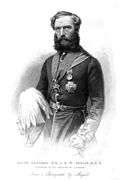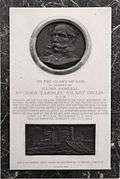John Eardley Inglis
Major General Sir John Eardley Wilmot Inglis KCB (15 November 1814 – 27 September 1862) was a British Army officer, best known for his role in protecting the British compound for 87 days in the siege of Lucknow.
Military career
In 1833 he joined the 32nd (Cornwall) Regiment of Foot, in which all his regimental service was passed. In 1837 he saw active service in Canada in the Lower Canada Rebellion, including the actions at St. Denis and St. Eustache.
During the Second Anglo-Sikh War, in 1848 to 1849 in the Punjab, He was in command at the Siege of Multan and at the Battle of Gujrat.
In 1857, on the outbreak of the Indian Mutiny, he was in command of his regiment at Lucknow. Sir Henry Lawrence being mortally wounded during the siege of the residency, Inglis took command of the garrison, and maintained a successful defence for 87 days against an overwhelming force. He was promoted to major-general and made K.C.B.
After further active service in India, he was, in 1860, given command of the British troops in the Ionian Islands. In 1860 he was given the colonelcy of his regiment, now the 32nd (Cornwall) Regiment of Foot (Light Infantry), a position he held until his death.
He died at Homburg on 27 September 1862, aged 47 and was buried in the crypt of Saint Paul's Cathedral, London.
Family
He was born in Nova Scotia, the son of John Inglis, the third bishop of that colony and grandson of Charles Inglis (bishop).
He was married to Julia Selina Thesiger (1833–1904), daughter of Frederick Thesiger[2] who wrote of her experiences during the siege of Lucknow including extracts from her diary.[3]
Their children included Rupert Edward Inglis who was an England rugby international, who was killed at the Battle of the Somme in 1916. His letters home to his wife from the front were published by his widow after the war.[4]
Legacy
Inglis is the namesake of Inglis Street, Halifax, Nova Scotia, which connects with Lucknow Street
Gallery
|
See also
References
- ↑ After his defence of Lucknow the Legislature of Nova Scotia presented him with a sword of honour. The blade of which, was made of steel from Nova Scotia iron pp.12-13
- ↑ "Hon. Julia Selina Thesiger". thepeerage.com. 13 February 2011. Retrieved 16 April 2011.
- ↑ Inglis, Julia Selina (1892). "The Siege of Lucknow: a Diary". A Celebration of Woman Writers. James R. Osgood, McIlvaine & Co.,. Retrieved 16 April 2011.
- ↑ "Diary of Rupert Inglis". www.inglis.uk.com. Retrieved 16 April 2011.
External links
-
 Lee, Sidney, ed. (1892). "Inglis, John Eardley Wilmot". Dictionary of National Biography. 29. London: Smith, Elder & Co.
Lee, Sidney, ed. (1892). "Inglis, John Eardley Wilmot". Dictionary of National Biography. 29. London: Smith, Elder & Co. - India and its mutiny: a lecture delivered before the Halifax Young Men's Christian Association, on Tuesday evening, March 16, 1858
| Military offices | ||
|---|---|---|
| Preceded by Sir Willoughby Cotton |
Colonel of the 32nd (The Cornwall) Regiment of Foot (Light Infantry) 1860–1862 |
Succeeded by Henry Dundas, 3rd Viscount Melville |




